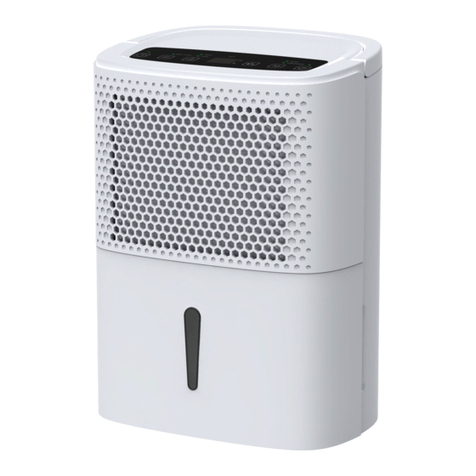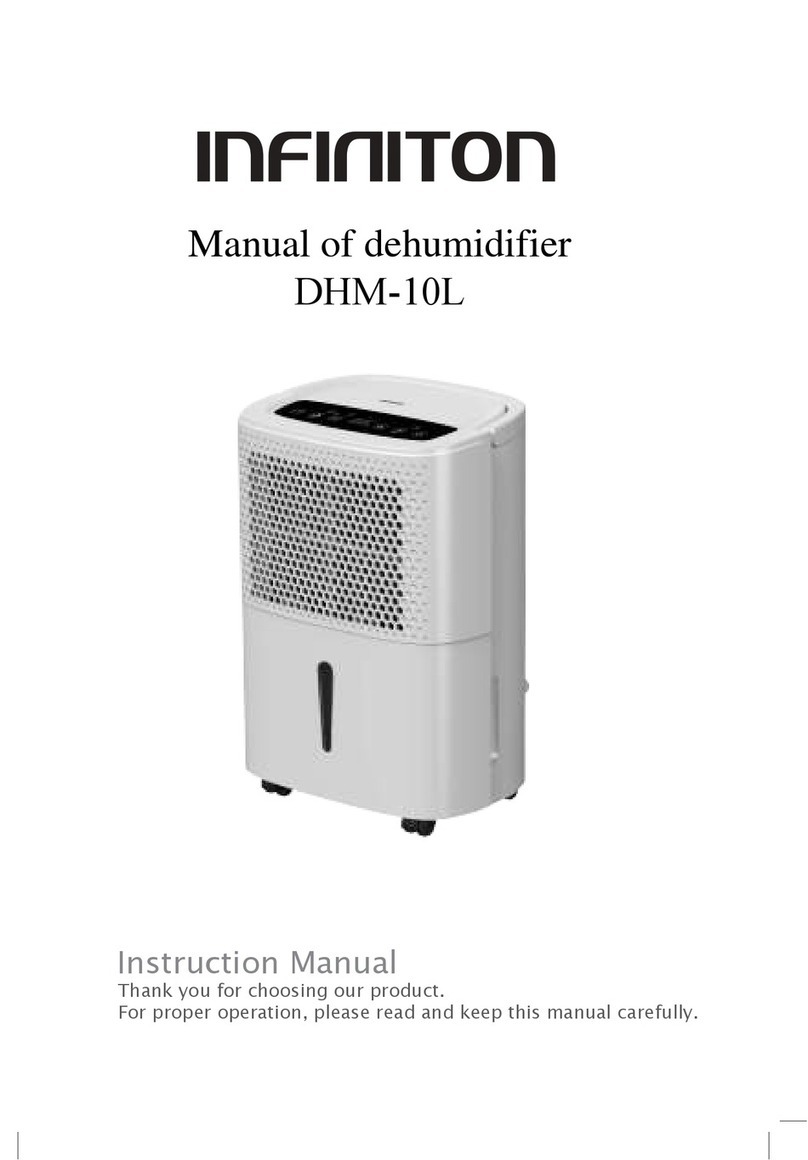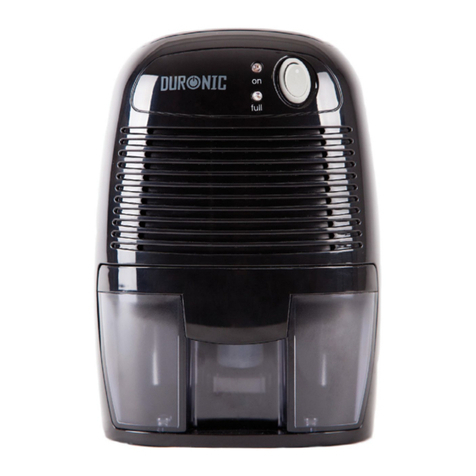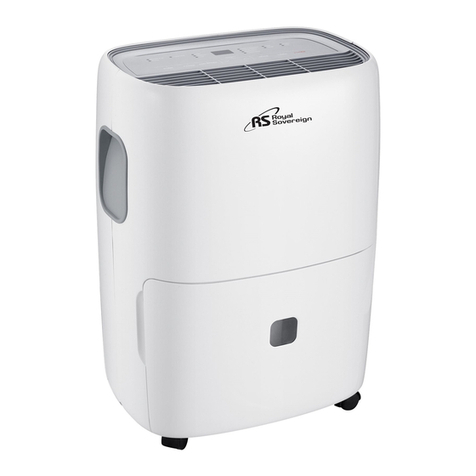Denco C14-1 User manual


Contents
DescriptionPage
Introduction3
Warranty3
Health and Safety4
Machine Card4
GeneralSafety Instructions5
Refrigerant R134a Safety Data6
Installation8
Installation – Electrical9
Installation – Mechanical9
Installation Recommendations9
Commissioning10
Start-Up Procedure10
Description ofOperation10
Schematic FlowDiagram11
GeneralArrangement Drawings12
TechnicalDescription ofComponents17
TechnicalData Tables18
ElectricalDescription20
Wiring Diagrams22
ControlofRefrigerant Discharge26
Log Book26
Routine Maintenance27
Fault Finding28
Notes31
Information
Thisproduct hasbeen manufactured for: Denco Limited
Dolphin House
Moreton Business Park
Moreton-on-Lugg
Hereford
HR4 8DS
Telephone: +44 (0) 1432 277277
Facsimile: +44 (0) 1432 377364

Important
The refrigerant availableon the CseriesofCompressed AirDryersis Refrigerant R134a or Refrigerant
R407C.It isimperativethat refrigerantsare not mixed. Alabelisfixed to each compressor, which identifiesthe
refrigerant being used withinthe unit, and that refrigerant ONLY shouldbe used inthe dryer. R134a &R407C
are ozone benign refrigerantsand meet the requirementsofthe revised “MontrealProtocol”. Theserefrigerants
require the useofESTER oil withinthe systemand not MINERAL oil asused with R22 systems,and therefore
again these oilsmust NOT be mixed.
Introduction
The Denco CseriesofCompressed AirDryersare used to removeentrained moisture fromcompressed air
supplysystemsand thusprotect the variouscomponentsand are designed such that routine maintenance is
kept to a minimum.
Mostpartsare fieldreplaceablebut shouldmajor maintenance or repairbe required pleaserefer to Denco
Limited or an authorised distributor.
NOTE: This manual applies ONLY to the Cseries of Compressed Air Dryers.For actual model refer to serial
plate fitted to the unit. For other ranges refer to the respective manuals.
Warning
TheseDryersare onlydesigned for usewith compressed airat or belowthe design maximumpressure (see
TechnicalData sheet(s) for maximumworking pressuresapplicable). These Dryersmust NOT be used for drying
any other gasesor fluidsat other pressures.Operation oftheseDryersusing compressed airofagreater
temperature than that specified will causeexcessivelyhigh pressuresinthe refrigeration system,which may be
dangerous.
The air supplied to the dryer must be free ofany corrosive or combustible gasesor impurities.
Warranty
The warranty will onlybe considered validifthe equipment supplied isinstalled, commissioned and maintained
inaccordance with the instructionsissued by Denco Limited. Furthermore the Company will not accept any
liability whatsoever shouldthe Dryer be installed incorrectlyor operated outside itsstated design dutiesand
operating conditionsor improper use be made ofthe equipment.

Health and Safety
Due regard shall be given to observing safeprocedureswhen working with or on the equipment. It isthe
responsibility ofthe Installer /Operator /Customer to ensure that the “Health and Safety at Work Act (1974)”
and NormalSafe Working Proceduresare adhered to at all times.
With reference to the "ControlofSubstancesHazardousto Health Regulations1988 (COSHH)” the following
paragraphshave been extracted fromDenco’sletter responding to information requested
“However, certainsubstancescontained withinmaterialsused inthe manufacture ofour unitscouldbe
hazardouswhen released, ifthe unit ismisused, abused or maintained by unskilled labour.
Fumeswouldbe released ifpipework or slab foaminsulation (Armaflexor similar), electricalinsulation or vinyl
coatingswere exposed to naked flame. It will be, therefore, that no naked flameshouldbe applied to any ofthe
above mentioned substances, nor to print, rubber or plastic parts.
Light oil isapplied to somebare metalpartsasaprotectivecoating and thiscouldcausedermaticreaction to
sensitive skin.
Refrigerantscontainhydrofluorocarbons(HFC’s). Glycol/water mix isused during manufacture but drained
before delivery. The quantitiesin use are minimalbut care should be taken in disposal.
Wetrustthat thisinformation issufficient but shouldyou require further information regarding our productsor
maintenance service, please contact our salesdepartment.”
Machine Card
In order to complywith BS EN 378-2:2000 “Refrigeration Systemsand Heat Pumps–Safety and Environmental
Requirements”, an adequatelyprotected card shall be situated near the operating site and mustbe clearly
readable. The card shall at least contain the following information:
1) Name, address and telephone number ofthe installer, hisservice department, or the person responsible
for the refrigeration and the addressesand telephone numbersofthe Fire Department, Police, Hospitals
and BurnsCentres
2) The refrigerant isR134a or R407C (refer to TechnicalData Table)
3) To shut downthe Compressed AirDryer inan emergency, switch off the unitusing the ON/OFF isolating
switch on the front panel. The mainssupply to the Dryer should be isolated at the mainsisolator.
4) MaximumAllowable Pressures
Compressed Air13 barg
5) Flammability Limitsin Air
NONE

General SafetyInstructions
IMPORTANT:THE FOLLOWING SAFETYPRECAUTIONS MUST BE READAND UNDERSTOOD BEFORE
REPAIR OR MAINTENANCE WORK IS ATTEMPTED.
General
Beware ofthe following danger areaswithin the dryer :
a) Any rotating components(fan etc.)
b) Sharp edges(coil fins, etc.)
c) Hot refrigeration pipework
d) Possible live electricalcomponentsor terminals
The refrigeration and compressed aircircuitscan operate at high pressuresand unauthorised tampering
may cause injury or damage.
Discharge fromthe condensate drain will contain oil, and therefore should be disposed ofsafely.
Do not place either temporary or permanent loadson or against the unit.
Mechanical
The dryer shall be fully disconnected or isolated fromthe compressed air supply and any remaining pressure
released safely.
The refrigeration circuitshall be fullyemptied ofgassafelyBEFORE work isattempted on any associated
components.Refrigerant gasmay be toxicand/or harmful(burns-both hot and cold), therefore usethe
necessary protective equipment (such asgogglesand gloves) at all timeswhen emptying the system,
Ifany heat or flameisto be used on or near the unitcare shall be taken to avoidcontact with combustible
surfaces.Furthermore, itshouldbe noted that the insulation materialsand refrigerant might giveoff toxic
fumeswhen heated. Whenever heat or flameisused the working area shall be thoroughlyventilated
BEFORE and DURING thisoperation. Proper fire precautionsshall be observed and the necessary fire
safety equipment on hand, typicalfor electrical, oil and foamfires,
The refrigerant used isrefrigerant R134a or R407C. No other type ofrefrigerant or mixture shall be used.
Ifrecharging or adding refrigerant to the unitensure correct refrigerant and oil are used, check labelson
compressor identifying refrigerant being used.
Ester oilsused insystemswith R134a &R407C are very hygroscopic(adsorb moisture very quickly),
therefore care shouldbe taken to ensure that the systemsand any ester oil containersare not leftopen to
atmosphere for any length oftime.
Ifany oil isremoved fromthe systemitshall be disposed ofsafely. Do not re-useor usefor any other
purpose.
When working on the dryersbeware ofany rotating componentsand any hot refrigerant pipework.
Observe any safety labelsfitted to variouspartsofthe dryer.
Electrical
The dryersare designed to operate onlyon a220/240 volt, 1phase, 50-60 Hz liveneutraland earth supply.
THE EARTH CONNECTION MUST NEVER BE OMITTED. The voltage tolerance for each modelisshown
on the respective wiring diagramin thisManual.
The dryer must be fully isolated fromthe supply BEFORE maintenance work isstarted.
The dryer MUST NOT be used on other supplieswithout prior approvalfromthe manufacturer.
The dryer should only be used in a SAFE (i.e. non- hazardous) area.
Observe any electricalsafety labelsfitted to variouspartsofthe dryer.
Solenoid coilsshould not be removed fromvalve stemuntil they have been electrically disconnected.

Refrigerant SafetyData
Reactivity Data
UnstableStability StableYES Conditions to Avoid
Use in presence ofnaked flames, red-hot surfaces. High moisture levels
Incompatibility (Materials and Conditions to Avoid)
May react violently with sodium, potassium, bariumor other alkali or alkaline earth materials.
Magnesiumand alloyscontaining more than 2% magnesium. All finely divided metals.
Hazardous Decomposition Products
Halogen acidsformed by thermaldecomposition.
Fire and Explosion Hazard Data
Flash Point (oC) Method
------ Auto-ignition Temperature (oC)
---
Flammable Limits (%by Vol. in Air) Lower Upper
Non Flammable--- ---
Would any materialsaturated Materials:
with thisproduct be subject to
spontaneouscombustion? No
Fire Extinguishing Data
Non flammable, not combustible.
Special Fire Fighting Procedures
Fire exposed containersshould be kept coolwith water sprays.
Usual Fire and Explosion Hazards
Will decompose in contact with high temperature sources, i.e. flames, electric arcs, etc. to produce irritating
and highly toxic acidic products. Breathing apparatusshould be worn ifrefrigerant isexposed to fire
conditions. Containersmay burst ifoverheated.
Precautions in Handling and Use
General Precautions
Atmospheric levelsshould be minimised and kept aslowasreasonably practicable belowhygiene standard.
Avoid inhalation ofhigh concentrationsofvapour. Heavy vapour collectsat lowlevels. Ventilate by extraction
at lowest level. Decomposesin flames, arcsand at red heat to toxic acid by-products. Avoid contact between
liquid and skin or eyes.
Ventilation Requirements
Ventilation may be required to achieve a sufficiently
lowexposure level. Extract at lowest level. Vapour
collectsin pits, trenches, basements, sewersand in
confined spacesand vessels.
Respiratory Protection
Where doubt existson atmospheric concentration and
particularly in confined spaces, self-contained
breathing apparatusshould be considered. Breathing
apparatusshould alwaysbe worn in a fire situation.
Protective Clothes
Where liquid splash isa possibility glovessuitable
for use in lowtemperaturesshould be worn e.g.
chlorobutylrubber with cotton liners.
Overalls.
Eye Protection
Goggles.
Storage
Containersshould be stored in a cooldry place away fromfire risk and sourcesofheat. They should not be
exposed to direct radiation fromsourcesofheat such assteamor electric radiators. Do not heat containers
beyond 45oC.

Health Hazard Data and First Aid
Short term effects of over exposure when:
In contact with skin: Liquid splashesmay cause freeze burns. No information found on irritancy or
sensitisation. There isno known hazard due to absorption through the skin.
In contact with eyes:Liquid splashesor vapour spray may result in freezing oftissue or eye fluids.
Inhaled: Very high concentrationsmay produce anaesthetic effectsand can act asan
asphyxiant by limiting available oxygen. They also may prove suddenly fatal
(cardiac sensitisation).
10 mineffective concentration 50 28% (Rat)
15 minlethalconcentration 50 >80% (Rat)
4 hr lethalconcentration 50 >50% (Rat)
Threshold for cardiac sensitisation 7.5% 5 min(Dog)
Ingested: Extremely unlikely to occur under normalindustrialuse.
Should thisoccur freeze burnswill result.
Long term effects of over exposure:
No effectshave been seen in ratsexposed to up to 50,000 ppmfor 90 days. It isnot teratogenic in ratsor
rabbits. Short-termscreening testsfor carcinogenicity have proved negative. No long-termeffectswere noted
when administered by gavage to ratsat a dose of300 mg/kg/day for one year and the ratsheld for the
remainder oftheir life span.
Occupational Exposure Limit (OEL):
1000 ppmv/v– 8 hr TWA value.
Emergency and First Aid Procedures:
Skin: Thawaffected areaswith water, remove contaminated clothing carefully, wash affected areas
ofskin thoroughly with copiousamountsofwarmwater. Ifsymptomsoccur, obtain medical
attention.
Eyes:Irrigate with eyewash solution or clean water for at least 10 minutes. Obtain immediate
medicalattention.
Inhalation: Remove patient to fresh air, keep warmand at rest, administer oxygen ifnecessary. Apply
artificialrespiration ifbreathing hasceased. Apply externalcardiac massage in the event of
cardiac arrest. The use of adrenaline or similar sympathomimetic drug should be
avoided. Obtain immediate medicalattention.
Ingestion: Highly unlikely. Should thisoccur freeze burnswill result.
Further Medical Advice
Symptomatic and supportive therapy asindicated. Cardiac sensitisation hasbeen described which may, in
the presence ofcirculating catecholaminessuch asadrenaline, give rise to cardiac arrythmiasand
subsequent arrest following exposure to high concentrationsofvapour. Therefore, adrenaline and similar
sympathomimetic drugsshould be avoided.
Spill or Leak Procedures
Steps to be taken in event of Spill or Release
Shut off leak ifwithout risk. Allowspilled liquid to evaporate. Contain spillage with sand or earth, prevent
liquid entering sewers, basementsand pitssince vapour may create suffocating atmosphere.
Neutralising Chemicals
None necessary.
Disposal Procedures
Best to recover and recycle. Ifthisisnot possible, destruction isto be in an approved facility, which is
equipped to absorb and neutralise acidsand other toxic processing products.

Installation - General
Storage
The equipment shouldbe stored inasecure frostfree area with amaximumambient of55°C and maximum
humidity of90% non-condensing.
Unpacking
Carefully remove the unit fromitspacking and examine it for obviousdefectsor damage including:
Paint damage.
Case deformation.
Integrity ofelectricalcable.
Breakage ofgauge glass (where applicable).
Ifany ofthe abovefaultsare noted, or any other defect or damage isobserved and itbecomesnecessary to
return the unit for rectification, thisshould be done in accordance with the procedure agreed with the supplier.
Moving
Due care shall be taken when moving the dryer not to causeinjury to personnelthrough improper safety
precautions.
NOTE: The dryer must be kept in the upright position at all timesto avoid damaging the compressor.
Lifting
The unitsare designed for fork lifting fromthe base. The baseisuneven –ensure that the forksare extended
fully through.
Do NOT use convenient pipes, boltsor aperturesin the dryer aslifting points.
Positionof Unit
The dryer should be placed on a firm, levelload bearing surface of adequate strength and asuitablearea be left
clear ofobstruction at the inlet and outlet grillesand the access panels(see note reference ambient
temperatures). To prevent airrecirculation the condenser coil mustbe situated at least500 mm fromawall,
partition etc. Sufficient space must be left for service access around the unit.
The C seriesunit are NOT suitable for direct wall mounting.
Ambient Temperatures
Care shouldbe taken to ensure that there isadequate aircirculation and the Dryersshouldnot be placed in
areaswhere the ambient temperature islikelyto exceed the recommended design maximum (refer to Technical
Data tables).
Removal of Covers
Generalaccess for installation or maintenance isviathe coverswhich are removableby removing the screws
around the panels.
Corrosion
Aircooled unitsare designed for operation innormalambient air. Any corrosiveagent inthe airsuch as
ammonia, sea water spray etc. will causecorrosion and wouldrequire specialprotectivemeasures.Corrosion
can result in release ofpressure and refrigerant.

Installation - Electrical
The C seriesDryersrequire a 220/240 Volt 1 phaseand neutral50-60 Hz supply. Aflying lead isinstalled on the
dryer for convenience. The cable core coloursare:
BrownLive
BlueNeutral
Green / YellowEarth
Ifthe unitisconnected to ajunction box,receiving itssupplyfromanother source (e.g., auxiliary contactsofa
mainstarter, or arelay), then itisimportant that electricalprotection isprovided by meansofasuitablyrated
H.R.C. fuselocated inthe line. Installation mustcomplywith the latestedition of IEE Wiring Regulations,Safety
Standardsand any LocalCodesofPractice that apply.
Installation - Mechanical
Connect the compressed airpipework to the Dryer using approved pipe and fittingsofthe correct rating and
type. To ensure damage doesnot occur to internalpipework and componentsduring the connection process,
removeaccess cover(s)and ifnecessary support the internalpipework /components.Pleaseensure that ALL
shut off valvesare fully open before starting unit.
The drainconnection shouldbe connected to asuitablysized drainline and piped to asuitableoil /water
separator prior to drain.
Installation Recommendations
The compressed airpipework shouldincorporate sufficient shut-off valvesto enablethe dryer to be by-passed
and/or disconnected in the event ofrepair or replacement.
Apurge valveshouldalsobe fitted at aconvenient point to enablethe airpressure to be released safelyand
gradually before undoing any connections.
Asuitablysized pressure safety device shouldbe fitted to prevent over-pressurisation ofthe compressed air
dryer.
Ifthe compressor pumpsintermittently, or the totalairdemand doesnot exceed the totalflowrate ofthe
compressor, the dryer MUST be installed downstreamofthe receiver.
Ifthe receiver issized to permitwide fluctuationson airdemand or ifpeak demand exceed compressor
maximumflowrate, the dryer SHOULD be installed upstreamofthe receiver.
Aminimum of 5micron (Denco recommend 1micron) pre-filter mustbe fitted to removeimpuritiesfromthe air
prior to itentering the dryer. Additionalfiltration may be required downstreamofthe dryer subject to the site
requirements.
1Air Compressor
2Receiver
3SafetyValve
4Shut off valve
5Pre-filter (1 micron)
6Refrigerant Dryer
7 After-filter
(0.01 micron, dust filter &
activated carbon asrequired)

Commissioning
The unitsare factory pre-set and commissioned and shouldnot need any fieldadjustment. However, ifafter a
period oftimethe unitisfound to be operating poorlyor incorrectly, thismay be due to arange offaultsor
problemswhich may be analysed by reference to the Fault Finding section ofthismanual.
Start-up Procedure
Important
Do not allow the compressed air to flow through the unit until the following checks have been made
AND THE UNITSWITCHED ON.
1. Switch the on-off switch /isolator to the "ON" (I)position. The following observationswill indicate correct
operation:
The fan will start
An airflowwill be felt fromthe condenser discharge grille
After 2minutes,the compressor will start and alow-levelnoisewill be heard similar to that ofa
domestic refrigerator.
2. After a further 5 minutes, slowly allowthe compressed air supply into the dryer.
3. Press the VALVE button to check the operation ofthe condensate discharge valve.
Note:
Somesafety cut outsare auto reset, and unless isolated fromthe mainsthe unitcan be re-started without
warning.
Pressure switchesshould be adjusted with the power off.
Any work done to the Compressed AirDryer involving entry into the controlpanel,fitting gauges,adjusting
controls, charging the system,evacuating the system or opening the system inany way, mustbe carried out
by aFULLY QUALIFIED REFRIGERATION ENGINEER. ACity and Guilds2078 or equivalent certificate is
strongly advised and will soon be mandatory.
Description of Operation
The saturated compressed airentersthe evaporator and ispre-cooled by the outgoing cooler air. The internal
refrigerant circuitisthen used to further coolthe airto itsrequired dewpoint. Once dewpoint isachieved, the
moisture condenses,and the water dropletsare ejected viathe condensate drainsystem.The cold, dry airis
then warmed by the incoming warmair and discharged, dry, to the downstreampipework.
The refrigerant circuitisofconventionaldesign operating on ozone benign Refrigerant R134a ofR407c and
incorporatesan hermeticcompressor, combined air/airand evaporator type heat exchanger, an aircooled
condenser, an expansion device (capillary tube or thermostaticexpansion valve), afilter/dryer, ahot gasby-
pass valve. The refrigeration circuit iscontrolled by meansofa simple but effective panelmounted controller
Schematic Flowand General Arrangement Drawings
Model NumbersSchematic Flow
Diagram Number Outline Arrangement
Drawing Number
C9-1, C14-1, C19-1PS1061-C-021PS1061-C-001
C31-2, C39-2, C58-2PS1061-C-021PS1061-C-002
C92-3, C120-3PS1061-C-021PS1061-C-003
C147-3PS1061-C-021PS1061-C-004
C175-4, C238-4PS1061-C-021PS1061-C-005

PS1061-C-021

PS1061-C-001

PS1061-C-002

PS1061-C-003

PS1061-C-004

PS1061-C-005

Technical Description of Components
1. Compressor
Thisisafullyhermetic, high back pressure singlephasetype; the internalcomponentsbeing mounted on
springsto minimise vibration.
2. Heat Exchanger
The heat exchanger iscoil / tube design and incorporatesan air/airand refrigerant /airheat exchanger with an
integralmoisture separator
3. AirCooledCondenser
A fan assisted air cooled condenser isused to removethe remaining heat from the refrigerant. Airmovement is
achieved by a multi-bladed propeller type fan directly driven by a single phase motor.
4. Hot Gas By-pass Valve
Thisvalveisinstalled such that discharge gasmay be diverted to the suction line when the suction temperature
startsto fall belowapreset level.Thislevelisset such that the moisture removed fromthe systemcannot
freeze in the evaporator.
5. Controller
A digitalreadout temperature controller isfitted to allowthe operating condition of the dryer to be monitored and
drain valve settingsto be adjusted.
6. Casing
The unitishoused incoated sheet steelcasing. Removablecoversare fitted where necessary to provide
access for service or repair.

Technical Data Table
ModelC9-1C14-1C19-1C31-2C39-2C58-2
NominalAirflow †m3/min0.580.831.161.832.333.5
NominalPressure Dropbar0.30.30.30.30.30.3
MaximumWorking Pressurebar131313131313
MaximumOperating Ambient°C434343434343
MaximumStanding Ambient°C535353535353
MinimumAmbient°C555555
Widthmm380380380388388388
Depthmm500500500718718718
Heightmm490490490600600600
Air ConnectionsBSP½½½111
Drain Connectionsmm od888888
ElectricalSupply §-220-240 volt / 1 phase / 50-60 Hz
Installed PowerkW0.450.570.660.960.960.85
Full Load CurrentAmps22.634.354.353.9
Refrigerant-R134aR407C
Refrigerant Chargekgs0.350.350.550.80.81.3
Notes:
†Nominalairflowin m3/min FAD at 20°C, working pressure 7.0 bar gauge with an inlet temperature of35°C inan
ambient of 25°C. Pleasenote: applying the Dryer for higher than standard ambient and /or airinlet temperature
will derate the performance.
‡Pressure switchesare factory set and must ON NO ACCOUNT be altered fromthe above settings.
§For voltage tolerance refer to respective schematic wiring diagram.

Technical Data Table
ModelC92-3C120-3C147-3C175-4C238-4
NominalAirflow †m3/min5.57.168.8310.514.33
NominalPressure Dropbar0.30.30.30.30.3
MaximumWorking Pressurebar1313131313
MaximumOperating Ambient°C4343434343
MaximumStanding Ambient°C5353535353
MinimumAmbient°C55555
Widthmm388388388388388
Depthmm86886886811481148
Heightmm740740740875875
Air ConnectionsBSP1½1½1½22
Drain Connectionsmm od88888
ElectricalSupply §-220-240 volt / 1 phase / 50-60 Hz
Installed PowerkW1.491.732.012.322.76
Full Load CurrentAmps6.767.869.1610.5612.56
Refrigerant-R407C
Refrigerant Chargekgs1.81.8222.5
Notes:
†Nominalairflowin m3/min FAD at 20°C, working pressure 7.0 bar gauge with an inlet temperature of35°C inan
ambient of 25°C. Pleasenote: applying the Dryer for higher than standard ambient and /or airinlet temperature
will derate the performance.
‡Pressure switchesare factory set and must ON NO ACCOUNT be altered fromthe above settings.
§For voltage tolerance refer to respective schematic wiring diagram.

Electrical Description
Descriptionof Components
1."ON / OFF" Switch
Thisswitchesthe live side ofthe power supply to the circuit. All modelsare fitted with a rotary type camswitch.
2.Compressor (complete with control box)
The compressor isasinglephasetype and incorporatesa"start" circuitto avoidriskofastalled motor on start-
up.
3.General
The aircooled condenser fan will run under the controlofthe controller sensing the temperature inthe
compressor discharge line.
Controller
The abovecontroller isfitted on the Cseriesofcompressed airdryers.It isused to controlthe fan and the hot
gasvalve(if fitted). It alsodisplaysthe dewpoint temperature and controlsthe timesettingsfor the drainvalve.
Thistime setting can be changed to suit the site requirementsasfollows.
Note: the “TEMP IN” and “TEMP OUT” buttons are not functional on the C series compressed air dryers
1. Valve Close Time (the time the valve isclosed between discharges. Variable between 1 & 20 mins)
Holdthe “UP” button for 15 seconds.The display will start blinking, displaying the valveclosetime. Press the
“UP” or “DOWN” arrows whilethe display isblinking to change the setting. Ifany other button ispressed, the
display will return to originaldisplay and ignore the newsetting. After the newvalue hasbeen set, leavethe
controller for 15 seconds. The display will return to the dewpoint value, and the newsetting will be stored.
2. Valve Open Time (the time the valve isopen to discharge. Variable between 4 & 20 secs)
Holdthe “CLOCK” button for 15 seconds.The display will start blinking, displaying the valveopen time. Press
the “UP” or “DOWN” arrows while the display isblinking to change the setting. Ifany other button ispressed, the
display will return to originaldisplay and ignore the newsetting. After the newvalue hasbeen set, leavethe
controller for 15 seconds. The display will return to the dewpoint value, and the newsetting will be stored.
This manual suits for next models
10
Table of contents
Popular Dehumidifier manuals by other brands
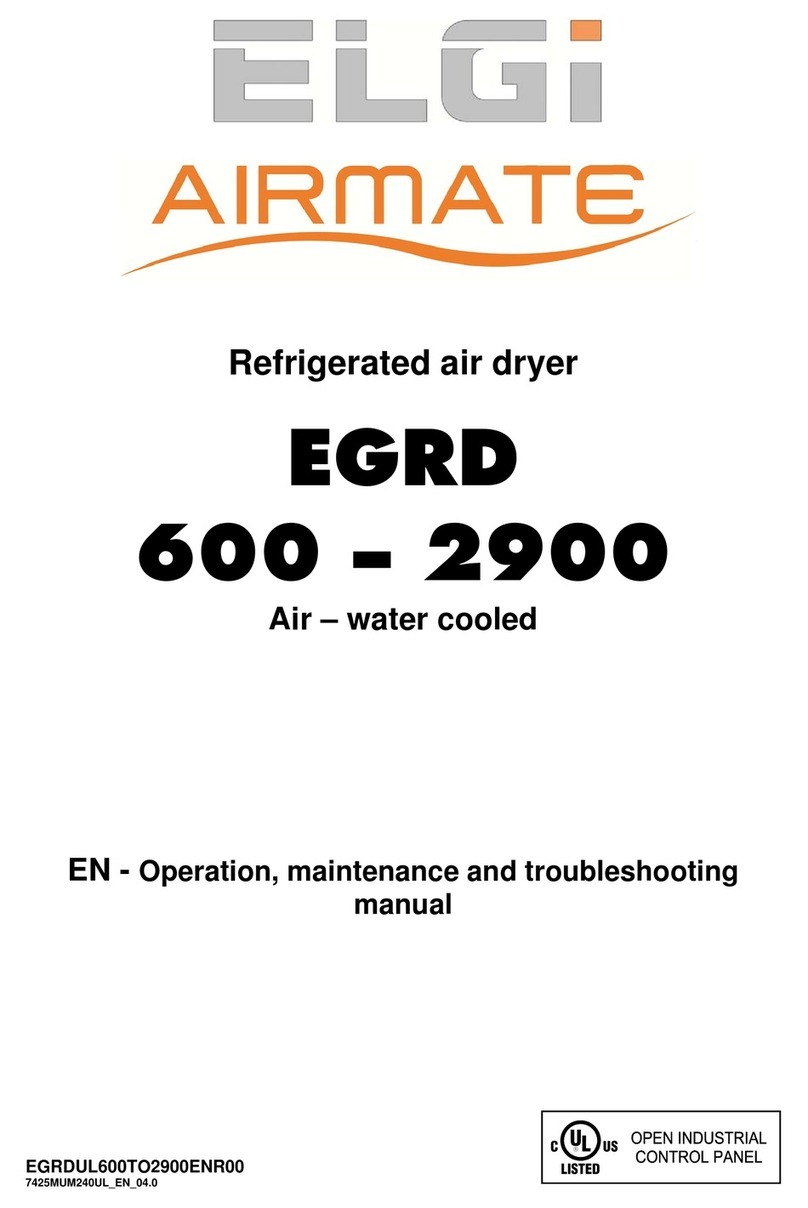
ELGi
ELGi EGRD 600 Installation, Operation, Maintenance and Troubleshooting

Breville
Breville All Climate LAD250 Instruction book

Seaira Global
Seaira Global WATCHDOG 900 Installation and operation manual
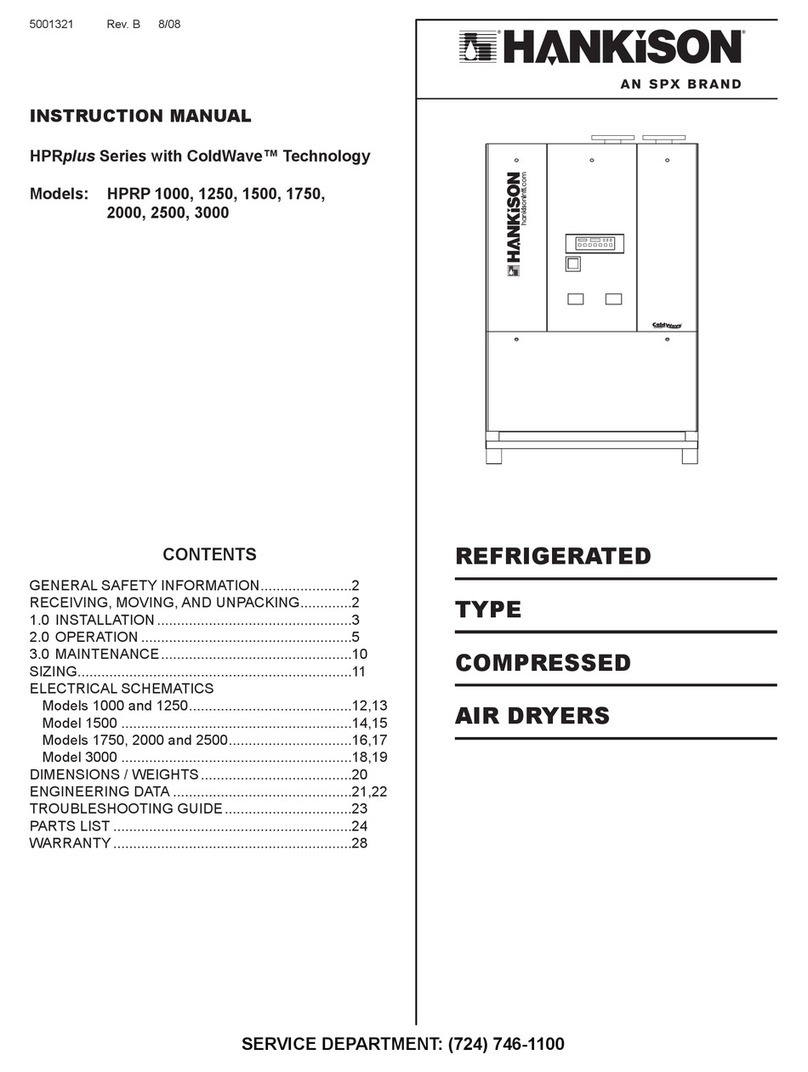
SPX
SPX Hankison HPRplus Series instruction manual

Ingersoll-Rand
Ingersoll-Rand EHD Series Operator's instruction manual
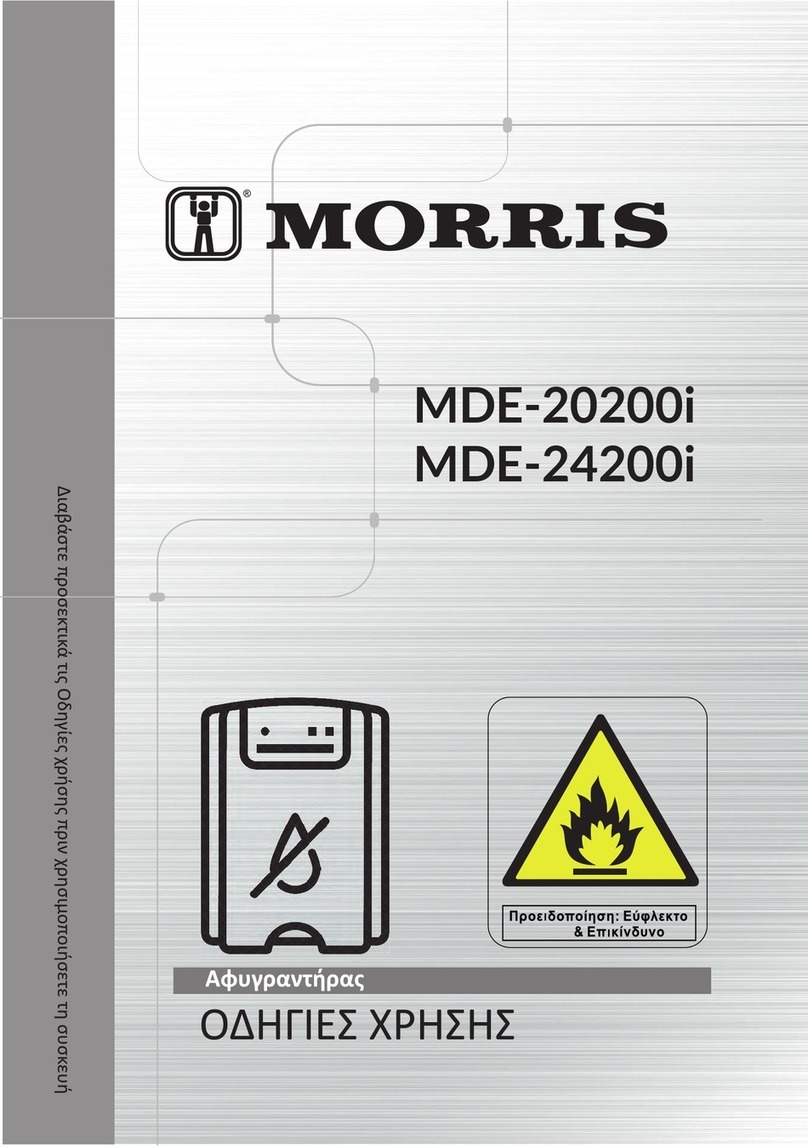
Morris
Morris MDE-20200i user manual
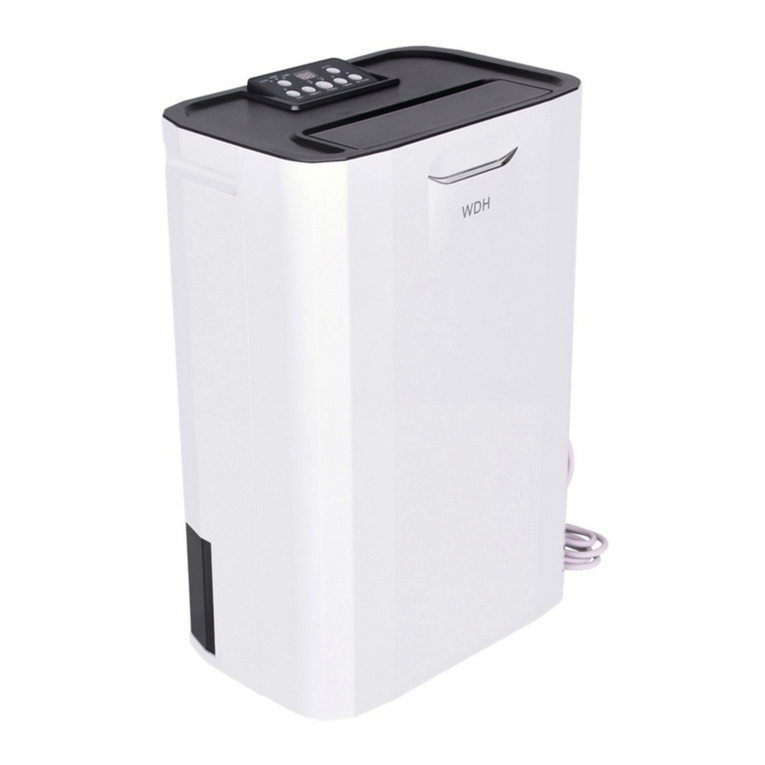
Aktobis
Aktobis WDH-DS3 operating manual
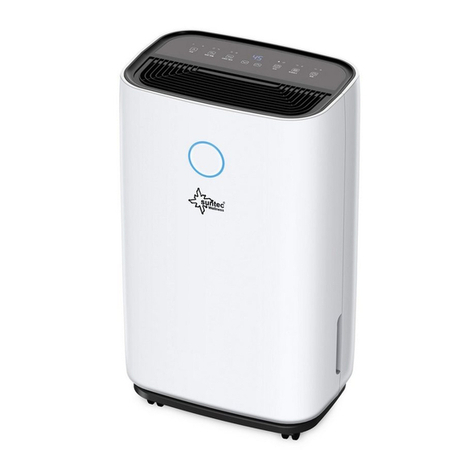
Suntec Wellness
Suntec Wellness Klimatronic DryFix 20 MAX manual
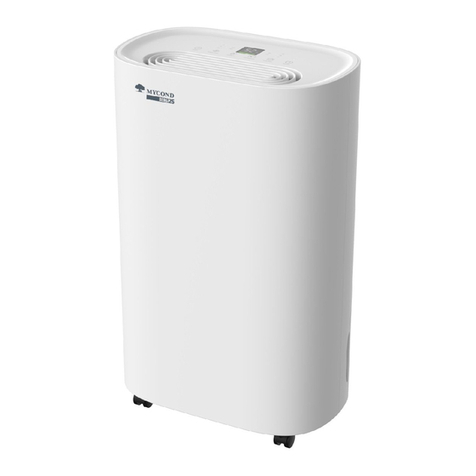
Mycond
Mycond BERG 25 user manual
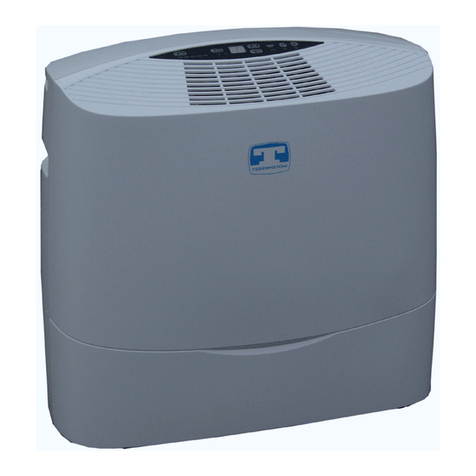
Teddington
Teddington SecoPure Installation and user manual
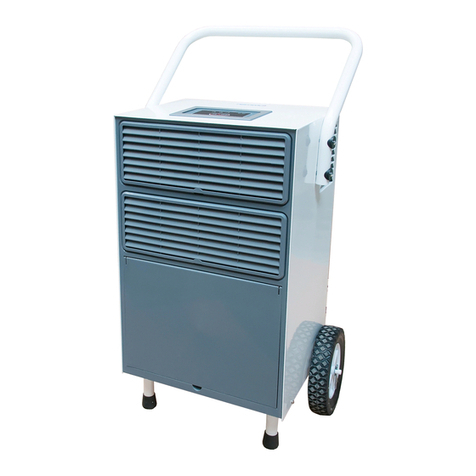
Nemaxx
Nemaxx BT55X Original operating instructions
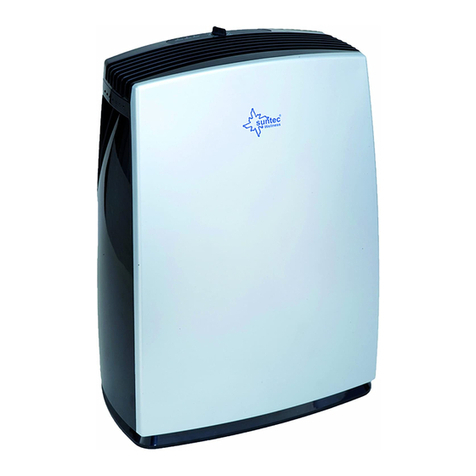
Suntec Wellness
Suntec Wellness Klimatronic Dry Fix 1000 operating instructions

